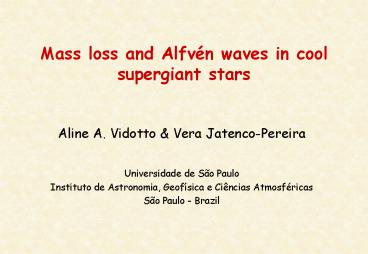Mass loss and Alfvn waves in cool supergiant stars - PowerPoint PPT Presentation
Title:
Mass loss and Alfvn waves in cool supergiant stars
Description:
Coronal holes: origin of fast solar wind u 600 km s-1. Cranmer & Ballegooijen (2005) ... A simplified coronal holes geometry ... – PowerPoint PPT presentation
Number of Views:36
Avg rating:3.0/5.0
Title: Mass loss and Alfvn waves in cool supergiant stars
1
Mass loss and Alfvén waves in cool supergiant
stars
Aline A. Vidotto Vera Jatenco-Pereira Universi
dade de São Paulo Instituto de Astronomia,
Geofísica e Ciências Atmosféricas São Paulo -
Brazil
2
Introduction Stellar mass loss has been
systematically derived from observations and is
present in almost all regions of the HR diagram.
In general, stars with the same spectral type
and luminosity class show characteristic values
of mass loss rate and terminal velocity
3
Late-Type stars
M? yr-1
In cool supergiant winds
km s-1
In general
The physical mechanism that drives these winds is
still uncertain.
4
- Sun
- - Sun ? benchmark for stellar astrophysics.
- Solar wind ? a necessary reference for the study
of stellar winds. - Magnetic fields ? play a significant role in
determining the equilibrium state of the plasma
in the solar atmosphere and solar wind (e.g.
Parker 1975, 1991 Priest 1999). - - The outflowing solar wind ? guided by open
mangetic flux tubes, and - ? many MHD processes have been proposed to
deposit heat and momentum at locations ranging
from - the extended corona to interplanetary
space.
5
Coronal holes origin of fast solar wind u? gt 600
km s-1.
The open magnetic field lines are expected to
expand superradially near surface i.e. into a
larger volume than would be expected if the field
were radial.
HAO/NCAR
intergranular flux tube
supergranular funnels
Cranmer Ballegooijen (2005)
6
Alfvén waves We have direct evidence for
Alfvén waves in the solar wind.
Alfvén waves are observed as large perturbations
in the magnetic field and negligible density
perturbations.
These waves propagate outward and the dissipation
of their energy and the transfer of their
momentum can accelerate the wind.
So, they are used as the main mechanism for wind
acceleration in many regions of HR diagram.
7
- Late-Type stars winds
- Several models have been proposed using the
transference of momentum and energy from Alfvén
waves to the gas. - Models
- - constant damping length (Hartmann, Edwards
Avrett 1982) - - radial geometry of magnetic field (Hartmann,
Edwards Avrett 1982) - - winds are isothermal (Jatenco-Pereira Opher
1989) - - winds with ad hoc temperature profile
(Falceta-Gonçalves Jatenco-Pereira 2002)
8
- The Model
- We suggest a model where we assume
- a flux of Alfvén waves as the main acceleration
mechanism. - temperature profile determined by solving the
energy equation taking into account both the
radiative losses and the wave heating. - ressonant damping mechanism for the Alfvén waves.
M? 16 M? r0 400 R? T0 3500 K B0 10
G ?A0 106 erg cm-2 s-1
Our model for a typical cool K5 supergiant star
9
Equations
Mass Momentum Energy
Heating due to Alfvén waves.
Radiative cooling.
Wave energy density.
10
A simplified coronal holes geometry
Super-radial at the base and radial after a
distance, called transition radius (rt). The
cross section of the flux tube, showed in the
figure, is given by Kuin and Hearn (1982) and
Parker (1963)
We assume
F ?t/ ?0 10 S 5.0
not on scale
11
Results
Velocity profile
At 300 r0
km s-1
M? yr-1
Consistent with observations.
12
Results
Temperature profile
We also applied the model to Betelgeuse with
results consistent with observations.
13
Open question
Generation of Alfvén waves can involve turbulent
motions in the convection zone below the
photosphere.
There are evidences for large convective cells in
the extended Betelgeuse atmosphere, for example.
If we can measure the change in flux due to this
convective motion we can study the possibility of
infer the turbulence level and the eventual wave
generation assuming that the turbulence can be
pictured as a hierarchy of eddies.
Other ideas on this subject are welcome!
14
Bibliography
Cranmer, S. R. van Ballegooijen, A. A. 2005,
ApSS 156, 265 Falceta-Gonçalves, D.
Jatenco-Pereira, V. 2002, ApJ 576, 976 Hartmann,
L., Edwards, S., Avrett, E. 1982, ApJ 261,
279 Jatenco-Pereira, V. Opher, R. 1989, AA
209, 327 Kuin, N. P. M. Hearn, A. G. 1982, AA
114, 303 Parker, E. N. 1963, Interplanetary
Dynamical Processes", Wiley New York Parker,
E. N. 1975, ApJ 198, 205 Parker, E. N. 1991, ApJ
372, 719 Pneuman, G. W., Solanki, S. K.
Stenflo, J. O. 1986, AA 154, 231 Priest, E. R.
1999, ApSS 264, 77































